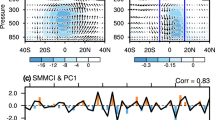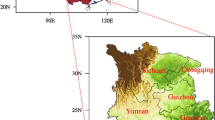Abstract
South China suffers from high temperature frequently in mid-summer and this study aims to explore the interdecadal change of interannual variation of the mid-summer temperature in South China. It is revealed that the relationship between South China temperature and atmospheric circulation and sea surface temperature anomaly (SSTA) experiences an interdecadal change around the early 1990s. Before the early 1990s, warmer summer in South China is associated with the mid-latitude teleconnection featured by higher pressure over the Ural Mountains and the Korean Peninsula and lower pressure around the Lake Baikal. South China is located at the southern flank of an anomalous high pressure. After the early 1990s, South China temperature is prominently influenced by the tropical SSTA, and meanwhile the mid-latitude teleconnection becomes much weaker. Warmer summer is associated with higher pressure centered over South China and the El Niño to La Niña transition phase. The higher pressure influencing South China is located more southwards after the early 1990s, and it is favored by the tropical SSTA. The warmer SST in summer over the western tropical Pacific enhances the local convection and triggers an anomalous local Hadley cell with stronger subsidence over South China, directly leading to higher pressure over South China. Moreover, the colder SST over the central–eastern Pacific induces an anomalous Walker circulation and further strengthens the convection over the western tropical Pacific, exerting an indirect impact on the higher pressure over South China. The relative role of the western Pacific warming and central–eastern Pacific cooling is verified by CAM4 simulations. The intimate relationship between the tropical SSTA and South China temperature occurs during the El Niño to La Niña transition phase, which is the case after the early 1990s and suggests higher predictability for South China temperature in the recent decades.











Similar content being viewed by others
References
Chen Z, Wen Z, Wu R et al (2015) Relative importance of tropical SST anomalies in maintaining the Western North Pacific anomalous anticyclone during El Niño to La Niña transition years. Clim Dyn 46:1027–1041
Chen R, Wen Z, Lu R (2016) Evolutions of the circulation anomalies and the quasi-biweekly oscillations associated with extreme heat events in South China. J Clim 29:6909–6921
Chen J, Wen Z, Wu R et al (2017) An interdecadal change in the intensity of interannual variability in summer rainfall over southern China around early 1990s. Clim Dyn 48:191–207
Dee D, Uppala S, Simmons A et al (2011) The ERA-interim reanalysis: configuration and performance of the data assimilation system. Q J R Meteorol Soc 137:553–597
Ding T, Qian W (2012) Statistical characteristics of heat wave precursors in China and model prediction. Chin J Geophys 55:1472–1486 (Chinese)
Ding Y, Wang Z, Sun Y (2008) Inter-decadal variation of the summer precipitation in East China and its association with decreasing Asian summer monsoon. Part I: observed evidences. Int J Climatol 28:1139–1161
Gao R, Wang L, Gao G (2008) The trend of variation in high temperature days during 1956–2006 in China. Adv Clim Change Res 4:177–181 (Chinese)
Gong D, Pan Y, Wang J (2004) Changes in extreme daily mean temperatures in summer in eastern China during 1955–2000. Theor Appl Climatol 77:25–37
He F, Xu J, Zhou W et al (2008) Evaluation on effects of meteorological conditions on electrical comsumption in megathermal days of Shanghai. Plateau Meteorol 27(Suppl):210–217 (Chinese)
Hu Z (1997) Interdecadal variability of summer climate over East Asia and its association with 500 hPa height and global sea surface temperature. J Geophy Res Atmos 102(D16):19403–19412
Kwon M, Jhun J, Wang B et al (2005) Decadal change in relationship between east Asian and WNP summer monsoons. Geophys Res Lett 32:101–120
Kwon M, Jhun J, Ha K (2007) Decadal change in east Asian summer monsoon circulation in the mid-1990s. Geophys Res Lett 34:377–390
Li T, Du Y, Mo Y et al (2014) Human health risk assessment of heat wave based on vulnerability: a review of recent studies. J Environ Health 31:547–550 (Chinese)
Li Z, Cao L, Zhu Y, Yan Z (2016) Comparing two homogenized datasets of daily maximum/mean/minimum temperatures in China during 1960–2013. J Meteorol Res 30:53–66
Liebmann B, Smith C (1996) Description of a complete (interpolated) outgoing longwave radiation dataset. Bull Am Meteorol Soc 77:1275–1277
Luo Q, Ji Z (2005) Climatological analysis of anomalous summer temperature patterns in Guangdong province. J Trop Meteorol 21:427–434 (Chinese)
Neale R, Richter J, Park S et al (2013) The mean climate of the community atmosphere model (CAM4) in forced SST and fully coupled experiments. J Clim 26:5150–5168
Rayner N, Parker D, Horton E et al (2003) Global analyses of sea surface temperature, sea ice, and night marine air temperature since the late nineteenth century. J Geophys Res 108:1063–1082
Ren G, Shen A, Ling C (2011) Cause and forecast of abnormal temperature in southern China during midsummer. J Meteorol Res Appl 32:1–5 (Chinese)
Sui C, Chung P, Li T (2007) Interannual and interdecadal variability of the summertime western North Pacific subtropical high. Geophys Res Lett 34:93–104
Sun J, Wang H, Yuan W (2011) Decadal variability of the extreme hot event in China and its association with atmospheric circulations. Clim Environ Res 16:199–208 (in Chinese)
Wang B, Wu R, Fu X (2000) Pacific–East Asian teleconnection: how does ENSO affect East Asian climate? J Clim 13:1517–1536
Wang B, Huang F, Wu Z et al (2009) Multi-scale climate variability of the South China sea monsoon: a review. Dyn Atmos Oceans 47:15–37
Wang W, Zhou W, Wang X et al (2013) Summer high temperature extremes in Southeast China associated with the East Asian jet stream and circumglobal teleconnection. J Geophy Res Atmos 118:8306–8319
Wang W, Zhou W, Li X et al (2016) Synoptic-scale characteristics and atmospheric controls of summer heat waves in China. Clim Dyn 46:2923–2941
Wei K, Chen W (2009) Climatology and trend of high temperature extremes across China in summer. Atmos Ocean Sci Lett 2:153–158
Wu R, Wen Z, Yang S, Li Y (2010) An interdecadal change in southern China summer rainfall around 1992/93. J Clim 23:2389–2403
Yan L, Huang X (2005) On anomalous climatic change of South China temperature in July. Meteorology 31:64–67 (in Chinese)
Yang H, Li C (2005) Diagnostic study of serious high temperature over South China in 2003 summer. Clim Environ Res 10:80–85 (in Chinese)
Yim S, Jhun J, Yeh S (2008) Decadal change in the relationship between east Asian-western North Pacific summer monsoons and ENSO in the mid-1990s. Geophys Res Lett 35:229–237
Yim S, Wang B, Kwon M (2014) Interdecadal change of the controlling mechanisms for East Asian early summer rainfall variation around the mid-1990s. Clim Dyn 42:1325–1333
Zeng J, Zhai Y, Wu Z, Hu K (2011) Effects of high temperature in summer on yield and its components in bitter gourd with 15 cross combinations and strains. Chin J Trop Crops 32:2025–2028 (in Chinese)
Zhang H, Wen Z, Wu R et al (2016) Inter-decadal changes in the East Asian summer monsoon and associations with sea surface temperature anomaly in the South Indian Ocean. Clim Dyn. https://doi.org/10.1007/s00382-016-3131-6
Acknowledgements
This work is jointly supported by National Key R&D Program of China (2016YFA0600601), National Natural Science Foundation of China (Grant Nos. 41605027, 41530530 and 41320104007).
Author information
Authors and Affiliations
Corresponding author
Rights and permissions
About this article
Cite this article
Chen, R., Wen, Z. & Lu, R. Interdecadal change on the relationship between the mid-summer temperature in South China and atmospheric circulation and sea surface temperature. Clim Dyn 51, 2113–2126 (2018). https://doi.org/10.1007/s00382-017-4002-5
Received:
Accepted:
Published:
Issue Date:
DOI: https://doi.org/10.1007/s00382-017-4002-5




